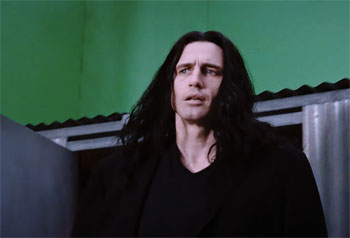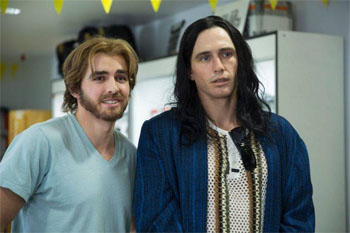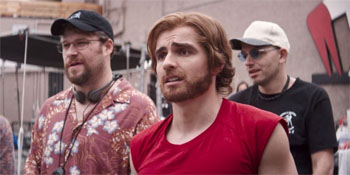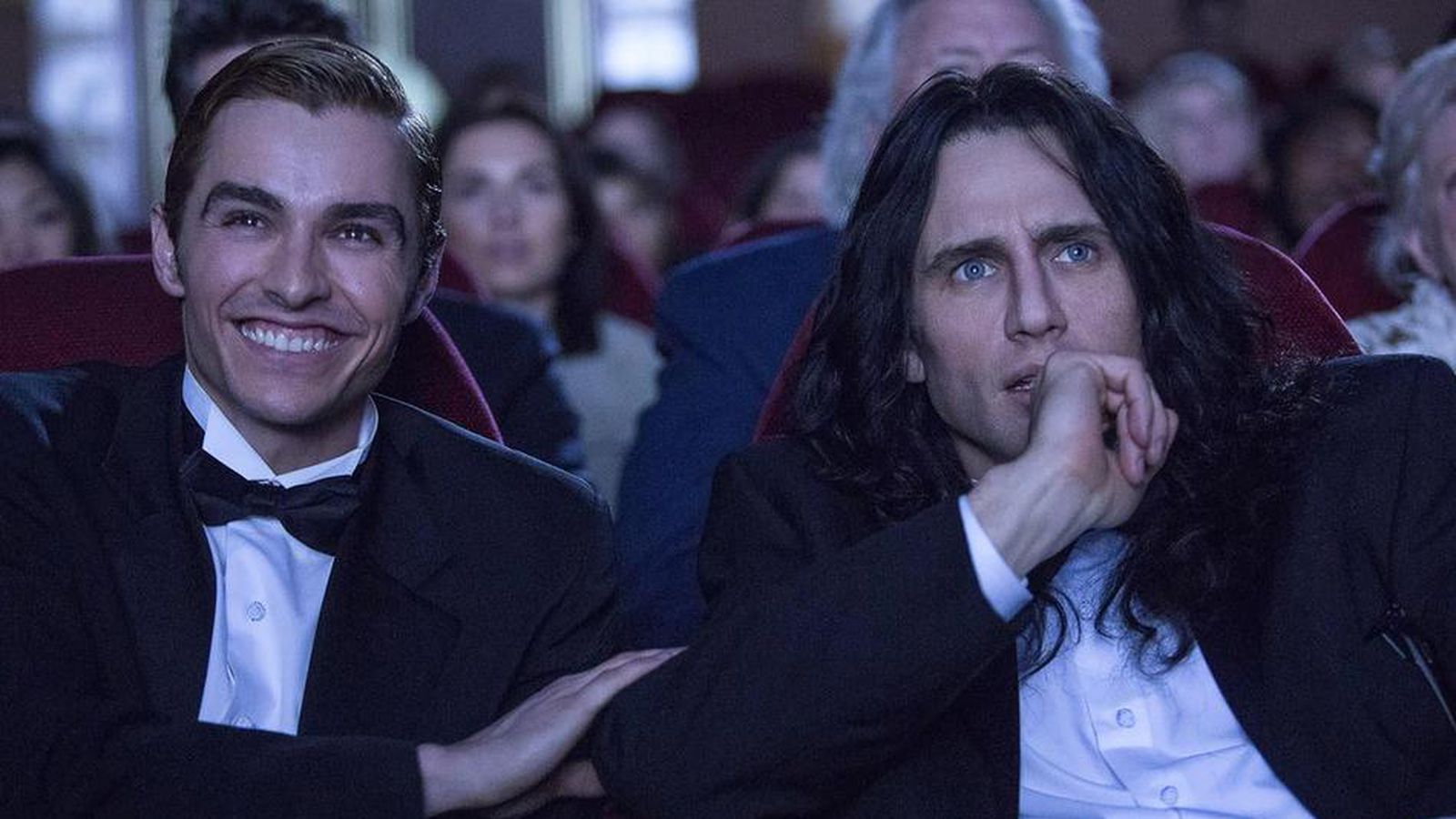The Disaster Artist (2017, Dir. James Franco):
Tommy’s a mystery. He’s better off always remaining a mystery. He says he’s from New Orleans, who am I to disagree? I don’t know how old he is, who am I to say? And I have no idea how he got his money. Who knows? I don’t even want to go there. — James Franco
Like most cult movies, Tommy Wiseau’s infamous The Room appeals to those who can get on its wavelength. But what is its wavelength, exactly? Too amateurish to be taken seriously, too bonkers to be interpreted as intentionally funny, The Room is a Rorschach test of a film. To some it’s schlock as ultimate artistic statement, so perfect in its awfulness that it hits heights regular comedies can’t dream of attaining. Others label the film as irredeemable tosh, regarding those who worship it at midnight screenings as hipper-than-thou hipsters hung up on irony and post-modern appreciation, and blind to the film’s utter lack of merit. Regardless of where you stand, The Room is a phenomenon that could only happen in Hollywood. Where else could something so terrible inspire such a fervent following? Where else would something so unfathomably bad lead to so many interpretations and speculations on what the damn movie is really all about?
 All talk about The Room‘s terrible acting and nonsensical plotting usually leads to the film’s central enigma: star, writer, and director Tommy Wiseau. A man with unknown origins, a strangled Continental accent, and an overwrought, rhythm-less performance style, Wiseau financed the film from his own pocket. He clearly wanted his film to be about something meaningful, a morality play out of Tennessee Williams, with a touch of James Dean (the film’s most famous line: “You’re tearing me apart, Lisa!“). The result of Wiseau’s hubris was a creation too strange to pass for real even in Hollywood — which makes it doubly ironic that he and his film are now the subject of a Hollywood movie, The Disaster Artist, that attempts to document that strangeness. The project is also something of a dare for James Franco, who like Wiseau, stars, produces and directs. If nothing else, we can dig Franco’s high-wire act as he attempts to replicate the real Wiseau’s look and mannerisms — including that crazy accent, of course. From the moment he’s introduced, writhing onstage during an acting class and screaming “Stellllaaaaa!” to the rafters, Franco remains true to his conception of the character, which is a feat of endurance in of itself.
All talk about The Room‘s terrible acting and nonsensical plotting usually leads to the film’s central enigma: star, writer, and director Tommy Wiseau. A man with unknown origins, a strangled Continental accent, and an overwrought, rhythm-less performance style, Wiseau financed the film from his own pocket. He clearly wanted his film to be about something meaningful, a morality play out of Tennessee Williams, with a touch of James Dean (the film’s most famous line: “You’re tearing me apart, Lisa!“). The result of Wiseau’s hubris was a creation too strange to pass for real even in Hollywood — which makes it doubly ironic that he and his film are now the subject of a Hollywood movie, The Disaster Artist, that attempts to document that strangeness. The project is also something of a dare for James Franco, who like Wiseau, stars, produces and directs. If nothing else, we can dig Franco’s high-wire act as he attempts to replicate the real Wiseau’s look and mannerisms — including that crazy accent, of course. From the moment he’s introduced, writhing onstage during an acting class and screaming “Stellllaaaaa!” to the rafters, Franco remains true to his conception of the character, which is a feat of endurance in of itself.
The film, based on the memoir of the same name by Greg Sestero and Tom Bissell, is told through the eyes of Sestero (James Franco’s brother Dave), a moderately hunky, under-talented actor who falls under Wiseau’s sway, and eventually becomes his partner and foil in the creation of The Room. Flabbergasted by Tommy’s wealth (“Why you poor?” Wiseau asks innocently when Greg is blown away by Tommy’s Mercedes), Greg sees in him a kindred spirit: an adventurer wanting to making it big in Tinseltown. Tommy, on the other hand, already considers himself a star. He cultivates a Garbo-like air of mystery (“Don’t tell anybody” is his common refrain every time he reveals anything about himself to Greg), screams through a read-through of Shakespeare in a diner, insists that he’s not a “villain” type despite his, um, villainous affect (“You have a malevolent presence,” an acting teacher tells Wiseau in a moment of prime understatement), and has ambitions beyond belief (“I don’t want a career, I want my own planet,” he announces). He’s by all appearances a very deluded man — or is there something deeper in the depths of those glazed blue eyes? Naive Greg seems to think so. The two of them buck each other up, Sestero a Frankenstein to Wiseau’s Monster, and before too long they’re pinky-swearing along the roadside where James Dean was killed, vowing “L.A. will know our names!”
 Needless to say, L.A. does come to know the two of them, even if it’s for the wrong reasons, and the knowledge of that outcome hamstrings Scott Neustadter and Michael H. Weber’s screenplay a bit. The film is thick with foreshadowing — when Greg and Tommy thrill to James Dean emoting in Rebel Without a Cause early in the movie, it’s all too apparent that the moment will be referred to and regurgitated later. Similarly, Greg and Tommy’s twisted BFF relationship is seen as the locus of everything; when Greg finds a girlfriend (underused Alison Brie), it’s none too surprising that Tommy works himself up into a fit of jealousy, with the friction influencing the making of The Room (whose storyline hinges on infidelity and betrayal). In its half-hearted attempts to peel back the onion and discover the motivations and reasons why The Room came out why it did, the story can only dig up clichés.
Needless to say, L.A. does come to know the two of them, even if it’s for the wrong reasons, and the knowledge of that outcome hamstrings Scott Neustadter and Michael H. Weber’s screenplay a bit. The film is thick with foreshadowing — when Greg and Tommy thrill to James Dean emoting in Rebel Without a Cause early in the movie, it’s all too apparent that the moment will be referred to and regurgitated later. Similarly, Greg and Tommy’s twisted BFF relationship is seen as the locus of everything; when Greg finds a girlfriend (underused Alison Brie), it’s none too surprising that Tommy works himself up into a fit of jealousy, with the friction influencing the making of The Room (whose storyline hinges on infidelity and betrayal). In its half-hearted attempts to peel back the onion and discover the motivations and reasons why The Room came out why it did, the story can only dig up clichés.
But while the Disaster Artist can’t escape its formulaic psychoanalytic trappings, where every notable bit in The Room stems from an inciting incident in the lives of our two would-be stars, there’s nothing formulaic about the actual making of The Room, and it’s in these segments that the film achieves comic lift-off. Infuriating and confounding his film crew, demanding the camera capture every nook and cranny of his naked ass as he makes love onscreen, trudging through an unfathomable 60-plus takes to speak four lines of dialogue that don’t even make sense anyway, Wiseau drives the production off the rails, and Franco’s loving recreations of The Room‘s sets, befuddled actors, and camera set-ups are pitched perfectly. If you’re into train wrecks, you’ll squirm with delight as Wiseau mistreats just about everyone, including himself. Through it all, it’s clear that something is eating away at him, driving him to these loopy extremes, but what is it? If The Disaster Artist suggests that Wiseau’s obsession with Greg fuels the nuttiness of The Room, it also recognizes that The Room‘s existence is ultimately inexplicable. (The Disaster Artist opens with a raft of stars, including Kristen Bell, Kevin Smith and Adam Scott, genuflecting about The Room‘s greatness, while struggling to articulate it.) Much like his movie, Wiseau himself remains baffling to the end. In The Disaster Artist he’s continually asked where’s he really from, how did he get his money, and how old he really is. The answers, as in real life, are unknowable, and unspoken.
 So if The Disaster Artist acknowledges the futility of even trying to understand its subject, what is its purpose? The answer to that lies in the movie’s title, which implies that Wiseau is indeed an artist, despite the disaster he creates. As an outsider who somehow found himself on the inside, and often gets criticized for his left-field acting and directing decisions, Franco clearly relates to the impulse to do something daring, and risk looking like a fool in the process. If Hollywood (represented here by Judd Apatow as a nay-saying film producer) scoffs at you, so what? There remains the thrill of the pursuit, and Franco is on the side of his non-talented dreamers. As Carolyn the actress (Jacki Weaver), best known for the immortal Room line “I definitely have breast cancer,” rhapsodizes: “Even the worst day on a movie set is better than a best day anywhere else.” Punch-drunk these actors and filmmakers may be, but they’re also drunk on the idea of creating something worthwhile, and who’s to say who’s the huckster and who’s getting huckstered when it comes to art? When we reach the climax, in which The Room‘s premiere audience gets to have the last word, we arrive at a strange inversion on the classic scrappy underdog tale: when something bad is considered great because it’s bad, do distinctions between good and bad really matter? The very thought must be anathema to respectable movie critics, but a gas to a prankster like Franco. “But it’s real life. Everyone acts so strange these days,” Wiseau says at one point as he explains the craziness of his script, and The Disaster Artist is a lark because it takes pleasure in such a world, where something as catastrophically strange as The Room can become as real as it gets as a phenomenon.
So if The Disaster Artist acknowledges the futility of even trying to understand its subject, what is its purpose? The answer to that lies in the movie’s title, which implies that Wiseau is indeed an artist, despite the disaster he creates. As an outsider who somehow found himself on the inside, and often gets criticized for his left-field acting and directing decisions, Franco clearly relates to the impulse to do something daring, and risk looking like a fool in the process. If Hollywood (represented here by Judd Apatow as a nay-saying film producer) scoffs at you, so what? There remains the thrill of the pursuit, and Franco is on the side of his non-talented dreamers. As Carolyn the actress (Jacki Weaver), best known for the immortal Room line “I definitely have breast cancer,” rhapsodizes: “Even the worst day on a movie set is better than a best day anywhere else.” Punch-drunk these actors and filmmakers may be, but they’re also drunk on the idea of creating something worthwhile, and who’s to say who’s the huckster and who’s getting huckstered when it comes to art? When we reach the climax, in which The Room‘s premiere audience gets to have the last word, we arrive at a strange inversion on the classic scrappy underdog tale: when something bad is considered great because it’s bad, do distinctions between good and bad really matter? The very thought must be anathema to respectable movie critics, but a gas to a prankster like Franco. “But it’s real life. Everyone acts so strange these days,” Wiseau says at one point as he explains the craziness of his script, and The Disaster Artist is a lark because it takes pleasure in such a world, where something as catastrophically strange as The Room can become as real as it gets as a phenomenon.

